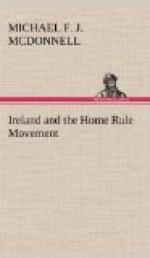In addition to the few English-managed estates it was only in Ulster that matters were otherwise, owing to the existence of the custom—an embryo copyhold, Lord Devon called it—known as tenant-right. On the various confiscations of land, grants of which had been made to the “undertakers,” many of the latter were either public bodies, such as the great City Companies, others were landlords who, even if not resident at a distance, had neither the means nor the inclination to spend the necessary money on their estates. This was provided by the tenant, who, without aid from the landlord, made improvements on his holding by his own labour; and in Ulster, where the tenants were settlers from England and Scotland, there arose an equitable proprietorship vested in the occupier, by which, on quitting the farm, he was entitled to claim from the new tenant a sum of money partly in compensation for the money and labour he had invested in the holding and partly as a price paid for the goodwill or possession, which the new tenant would have no other means of acquiring. The nature of this “Ulster Custom,” which, until 1870, had no sanction or protection from the law, was clearly defined by the Master of the Rolls, in the case of M’Elroy v. Brooke, in the following words:—“The essentials of the custom are the right to sell, to have the incoming tenant, if there be no reasonable objection to him, recognised by the landlord, and to have a sum of money paid for the interest in the tenancy transferred.” The English system we see then, with its competitive rent fixed by contract, and subject to the laws of supply and demand, did not exist; the social and prescriptive ties which in England bound the owner and the occupier to each other never arose under this state of things, and in their absence did not arise one of the strongest inducements to a landed gentry to live on their estates and to concern themselves in the welfare of their tenants, a social system which, by the interchange of kindly offices wherever in England the proprietors live on their property, does much to make the countryside attractive to the poorer classes and to check migration.
There is no more erroneous idea than to suppose, as do some people, that there was a large body of resident landed proprietors in Ireland until the land war drove them to seek safety across the Channel. As a matter of fact, long before this had begun there existed an absentee aristocracy dependent on middlemen or agents—“the vermin of the country,” Arthur Young called them—who constituted a mere mechanical medium for the collection of rent, and as such were the worst exponents of the amenities which, in happier circumstances, are supposed to subsist between owners and occupiers of agrarian land. At the beginning of the nineteenth century the increase of population in the island and the high prices resulting from the war led to a very great sub-division of holdings, while the exercise of the franchise by the forty shillings freeholder until the year 1829 provided an additional inducement to the landlord to multiply the number of tenants on his land, since by doing so he increased the number of votes under his control, and, pari passu, his political influence.




